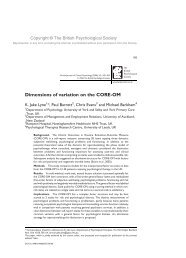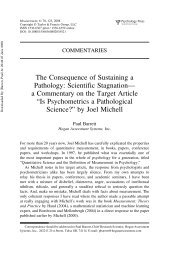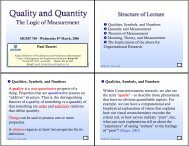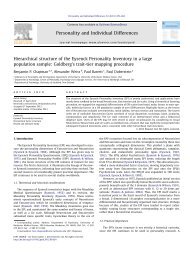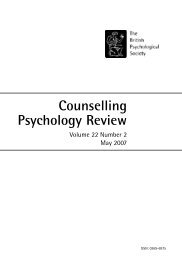Psychophysiological Methods - Paul Barrett
Psychophysiological Methods - Paul Barrett
Psychophysiological Methods - Paul Barrett
- No tags were found...
You also want an ePaper? Increase the reach of your titles
YUMPU automatically turns print PDFs into web optimized ePapers that Google loves.
Breakwell-3389-Reference.qxd 2/7/2006 9:03 PM Page 490Everitt, B. S. (1977). The analysis of contingency tables. London: Chapman & Hall.Everitt B. S., Landau, S. & Leese, M. (2001). Cluster analysis. London: Arnold.Ewing, K. P. (2000). Dream as symptom, dream as myth: A cross-cultural perspective ondream narratives. Sleep and Hypnosis, 2(4), 152–159.Exner, J. (1986). The Rorschach: A comprehensive system (2nd edn). Chichester: Wiley.Eysenck, H. J. (1952). The effects of psychotherapy: An evaluation. Journal of ConsultingPsychology, 16, 319–324.Eysenck, H. J. (1994). Meta-analysis and its problems. British Medical Journal, 309,789–792.Eysenck, H. J. & Eysenck, S. B. G. (1975). Manual for the Eysenck PersonalityQuestionnaire. London: Hodder & Stoughton.Eysenck, H. J. & Eysenck, S. B. G. (1976). Psychoticism as a dimension of personality.London: Hodder & Stoughton.Ezzy, D. (1998). Theorizing narrative identity: Symbolic interactionism and hermeneutics.Sociological Quarterly, 39, 239–252.Fals Borda, O. (2001). Participatory action research in social theory: Origins and challenges.In P. Reason & H. Bradbury (Eds), Handbook of action research: Participativeinquiry and practice (pp. 27–37). London: Sage.Farell, B. & Pelli, D. G. (1998). Psychophysical methods. In R. H. S. Carpenter &J. G. Robson (Eds), Vision research: A practical guide to laboratory methods(pp. 129–136). Oxford: Oxford University Press.Farsides, T. (2004). Cognitive mapping: Generating theories of psychological phenomenafrom verbal accounts and presenting them diagrammatically. In G. M. Breakwell(Ed.), Doing social psychology research. Oxford: Blackwell.Feldman, C. F. (2001). Narratives of national identity as group narratives: Patterns ofinterpretive cognition. In J. Brockmeier & D. Carbaugh (Eds), Narrative and identity:Studies in autobiography, self and culture (pp. 129–144). Amsterdam: JohnBenjamins.Field, A. P. (2003). Can meta-analysis be trusted? The Psychologist, 16, 642–645.Field, A. & Hole, G. (2003). How to design and report experiments. London: Sage.Fielding, N. (Ed.) (2003). Interviewing. London: Sage.Fisch, B. J. (1999). Fisch and Spehlmann’s EEG primer: Basic principles of digital andanalog EEG (3rd ed.). Amsterdam: Elsevier.Fischer, G. & Molenaar, I. (1995). Rasch models: Foundations, recent developments andapplications. London: Springer.Fisher, R. A. (1935). The design of experiments. Edinburgh: Oliver & Boyd.Fleiss, J. L. (1971). Measuring nominal scale agreement among many raters.Psychological Bulletin, 76, 378–382.Flick, U. (1998). An introduction to qualitative research. London: Sage.Fontana, A. & Fry, J. H. (2000). The interview: From structured questions to negotiatedtext. In N. K. Denzin & Y. S. Lincoln (Eds.), Handbook of qualitative research (2nd ed.).Thousand Oaks, CA: Sage.Forbat, L. (2005). Talking about care: Two sides to the story. Bristol: Policy Press.Freeman, P. R. (1973). Table of d’ and β. Cambridge: Cambridge University Press.Fried, R. & Grimaldi, J. (1993). The psychology and physiology of breathing. London:Plenum.490 RESEARCH METHODS IN PSYCHOLOGY



